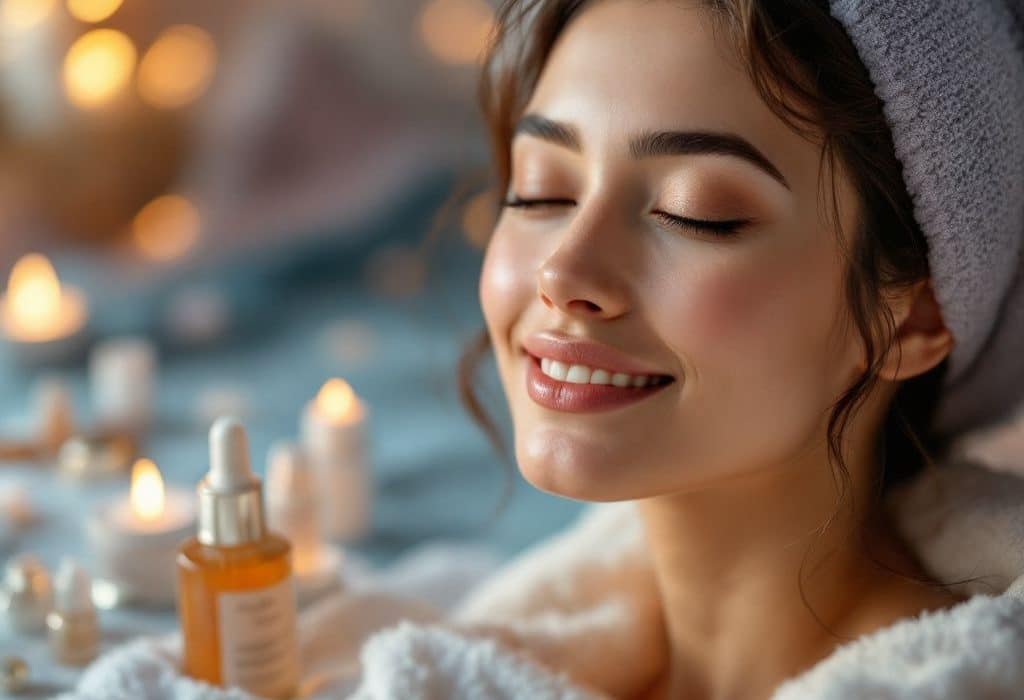In the ever-evolving world of skincare, achieving that coveted night glow has become a pinnacle of beauty success. With countless products touting miraculous results, it’s crucial to cut through the noise and create a tailored nighttime skincare ritual that truly honors your skin’s unique needs. Whether you’re aiming for the best night cream for glowing skin or exploring overnight glow treatments, the right approach can make all the difference. Let’s dive deep into strategies that are backed by science and capable of transforming your nighttime routine into a ritual of rejuvenation.
Understanding Your Skin: The First Step to a Glowing Complexion
Skin Types: The Foundation of Your Routine
Before selecting products, it’s essential to understand your skin type—essentially how your skin behaves under various conditions. Your skin might be oily, dry, combination, or sensitive. Knowing this helps in customizing your skincare ritual to harness the full potential of each product.
- Oily skin often benefits from non-comedogenic products, which don’t block pores.
- Dry skin thrives with hydrating ingredients like hyaluronic acid.
- Combination skin needs a balanced approach to manage varying textures in different zones.
- Sensitive skin requires soothing, fragrance-free formulations to avoid irritation.
Studies such as one published in the *Journal of Dermatological Science* emphasize the importance of tailored skincare, noting a significant reduction in issues like acne and dryness when routines are customized to specific skin types.
The Circadian Rhythm: Timing Is Everything
Our skin operates on a circadian rhythm—its own internal clock that affects how skin cells regenerate. At night, the skin’s regeneration process peaks, renewing skin cells efficiently and repairing damage from environmental exposure during the day.
Creating a skincare ritual that aligns with this natural process enhances its efficacy. For example, applying retinoids or peptides in the evening allows these powerful agents to penetrate during the prime renewal time, fostering nighttime repair.

Components of a Successful Night-Time Skincare Ritual
Cleanse Thoroughly, Yet Gently
The first step in the nightly routine is cleansing, which removes makeup and dirt accumulated during the day. However, harsh cleansers or over-cleansing can strip away essential moisture.
- Tip: Opt for a sulfate-free cleanser with a neutral pH level that respects the skin’s natural barrier. According to studies in Dermatologic Clinics, a pH balance close to the skin’s natural acidic mantle (around 5.5) can prevent irritation and dehydration.
The Power of Serums: Targeted Treatment for Every Concern
Serums are potent, concentrated formulations packed with active ingredients. They’re designed to tackle issues like hyperpigmentation, fine lines, and dehydration.
- Example Ingredients:
- Vitamin C: Brightens skin and helps in collagen synthesis.
- Niacinamide: Eases inflammation and redness while supporting the lipid barrier.
- Hyaluronic Acid: Binds moisture to skin cells for deep hydration.
A study in the *Journal of Cosmetic Dermatology* found that using serums with peptides could visibly reduce wrinkle depth by up to 20%.
Best Night Cream for Glowing Skin: Sealing in the Goodness
Finding the best night cream for glowing skin is pivotal to locking in hydration and reinforcing the skin barrier. Night creams are generally thicker and packed with ingredients that nourish overnight.
- Top Ingredients to Consider:
- Retinoids: Encourage cell turnover and stimulate collagen production.
- Ceramides: Repair and strengthen the skin barrier.
- Alpha Hydroxy Acids (AHAs): Offer gentle exfoliation to refine texture.
Real-World Application: Investing in a night cream like the **[Brand Name] Radiant Night Cream**, which combines Ceramides and AHAs, can foster both hydration and gentle exfoliation.

Incorporating Overnight Glow Treatments
Overnight glow treatments are like booster shots for your skin, providing an intensive option for evenings when your skin demands extra attention. These are generally used 1-2 times a week.
- Exemplary Ingredients:
- Overnight Masks: Infuse skin with nutrients for an instantly moisturized, plump look.
- Exfoliating Peels: Remove dead skin cells effectively and promote regeneration.
Clinical evidence shows that overnight treatments like hydrogel masks can improve skin moisture content significantly, per research in *Skin Research and Technology*.
Holistic Practices for Night Glow Enhancement
A Balanced Diet: Nourishing Your Skin from Within
Just as important as topical care, diet plays a substantial role in maintaining skin health.
- Nutrient-Rich Foods:
- Omega-3 Fatty Acids: Found in fish oils, known to enhance the skin’s barrier function.
- Antioxidants: Foods rich in antioxidants, such as berries and green leafy vegetables, neutralize free radicals.
Quality Sleep: The Ultimate Nighttime Renewal
Quality sleep contributes more to skin health than most people realize. A study from the *Clinical and Experimental Dermatology* journal illustrated that subjects who consistently experienced quality sleep showed less aging compared to those who didn’t, attributed to the enhanced repair process.
Stress Management: Mental Well-Being for Physical Glow

Stress can exacerbate skin conditions, leading to inflammation and breakouts. Practices like yoga and meditation foster relaxation, aiding in the reduction of cortisol levels, known to wreak havoc on skin health when elevated for sustained periods.
Evaluating and Adjusting Your Routine
As seasons change, so too will your skin’s requirements. What works in humid summers may not in dry winters. Pay attention to how your skin responds and adjust your ritual accordingly.
A survey from the *International Journal of Cosmetic Science* highlights that consumers who adjusted their routines cross-seasonally noticed more significant improvements in their skin’s texture and glow.
Keep a Skincare Diary
Documenting your skin’s response to different products over time can provide insights into which ones perform best, allowing you to tweak your routine proactively.
- Pro Tip: Note the time of year, climate conditions, and changes in skin behavior when a new product is introduced.
Conclusion
A luminously glowing complexion is more than feasible with a night skincare ritual finely tuned to your skin’s unique demands. Embrace this ritualization not merely as a routine, but as a nightly dedication to personal care—a sacred time to renew, repair, and relax.
Nurturing your skin in alignment with industry standards, leveraging the best night cream for glowing skin, and intelligently applying overnight glow treatments positions you not only closer to the skin of your dreams but also to a state of holistic well-being.
By following these principles, informed by scientific research and real-world evidence, your path to radiant skin becomes less of a secret and more of a cherished ritual you will wish to share. 🌜✨
Frequently Asked Questions
What are the benefits of using a hair mask in my hair care routine?
Using a hair mask can provide several benefits, including hydration, smoothing, strengthening, curl definition, heat protection, and damage repair. Hair masks infuse the hair with moisture, help coat the hair shaft to seal split ends, reduce breakage, and protect the hair from heat styling and environmental damage[1][4].
What ingredients should I look for in a hair mask?
Effective hair masks often include ingredients such as coconut oil, argan oil, shea butter, honey, avocado oil, green tea, and coconut water. These ingredients provide nourishment, moisturize, and protect the hair, offering benefits like softening, moisturizing, and protecting against damage[2][5].
How often should I use a hair mask in my routine?
You should use a hair mask whenever your hair feels dry, unmanageable, or in need of intense hydration. This can vary depending on your hair type and needs, but generally, using a hair mask once or twice a week can help maintain healthy and moisturized hair[1][4].
How do I apply a hair mask for the best results?
To apply a hair mask effectively, shampoo your hair first, then apply the mask, focusing especially on the ends where hair tends to be the most damaged. Leave the mask on for anywhere from 10 minutes to overnight, depending on the type of mask and your hair’s needs[1][4].
References


